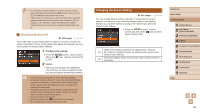Canon PowerShot SX60 HS User Guide - Page 87
Adjusting the Flash Exposure Compensation
 |
View all Canon PowerShot SX60 HS manuals
Add to My Manuals
Save this manual to your list of manuals |
Page 87 highlights
Slow Synchro Fires to illuminate the main subject (such as people) while shooting at a slower shutter speed to illuminate backgrounds out of flash range. ●● In [ ] mode, mount the camera on a tripod or take other measures to keep it still and prevent camera shake. Additionally, you should set [IS Mode] to [Off] when using a tripod or other means to secure the camera (=90). ●● In [ ] mode, even after the flash fires, ensure that the main subject does not move until the shutter sound is finished playing. Off For shooting without the flash. ●● If a blinking [ ] icon is displayed when you press the shutter button halfway in camera-shake inducing, low-light conditions, mount the camera on a tripod or take other measures to keep it still. Adjusting the Flash Exposure Compensation Still Images Movies Just as with regular exposure compensation (=72), you can adjust the flash exposure from -2 to +2 stops, in 1/3-stop increments. ●●Raise the flash, press the [ ] button and immediately turn the [ ] dial to choose the compensation level, and then press the [ ] button. ●●The correction level you specified is now displayed. ●● When there is a risk of overexposure, the camera automatically adjusts the shutter speed or aperture value during the flash shots to reduce washed-out highlights and shoot at optimal exposure. However, you can deactivate automatic adjustment of the shutter speed and aperture value by accessing MENU (=30) and choosing [ ] tab ► [Flash Control] ► [Safety FE] ► [Off]. ●● You can also configure the flash exposure compensation by accessing MENU (=30) and choosing [ ] tab ► [Flash Control] ► [Flash Exp. Comp]. ●● You can also access the [Built-in Flash Settings] MENU screen (=30) as follows (except when an optional external flash is mounted). -- When the flash is up, press the [ ] button and immediately press the [ ] button. Before Use Basic Guide Advanced Guide 1 Camera Basics 2 Auto Mode / Hybrid Auto Mode 3 Other Shooting Modes 4 P Mode 5 Tv, Av, M, C1, and C2 Mode 6 Playback Mode 7 Wi-Fi Functions 8 Setting Menu 9 Accessories 10 Appendix Index 87















